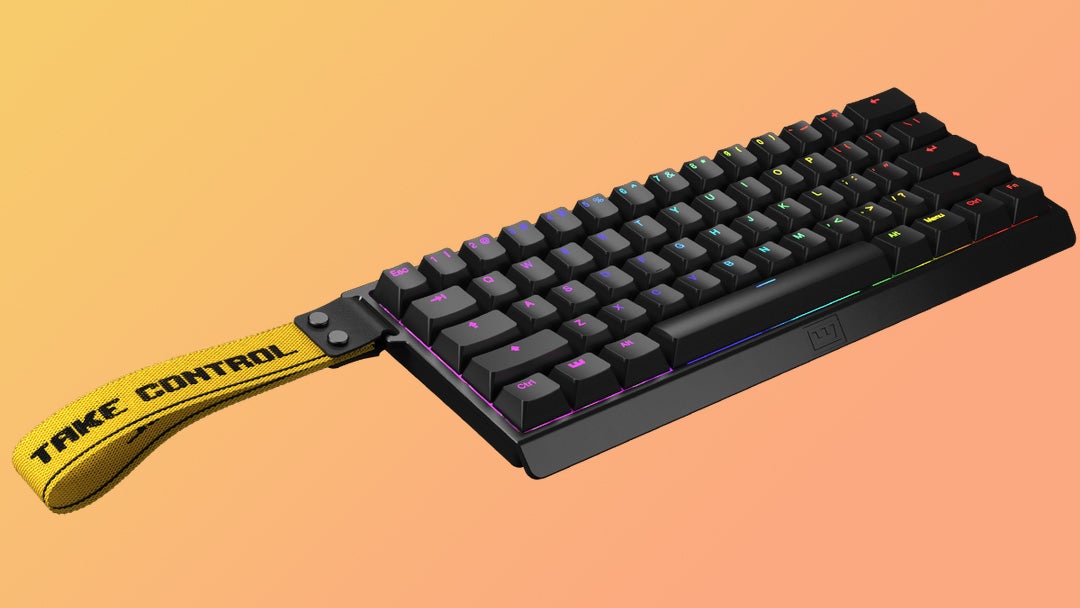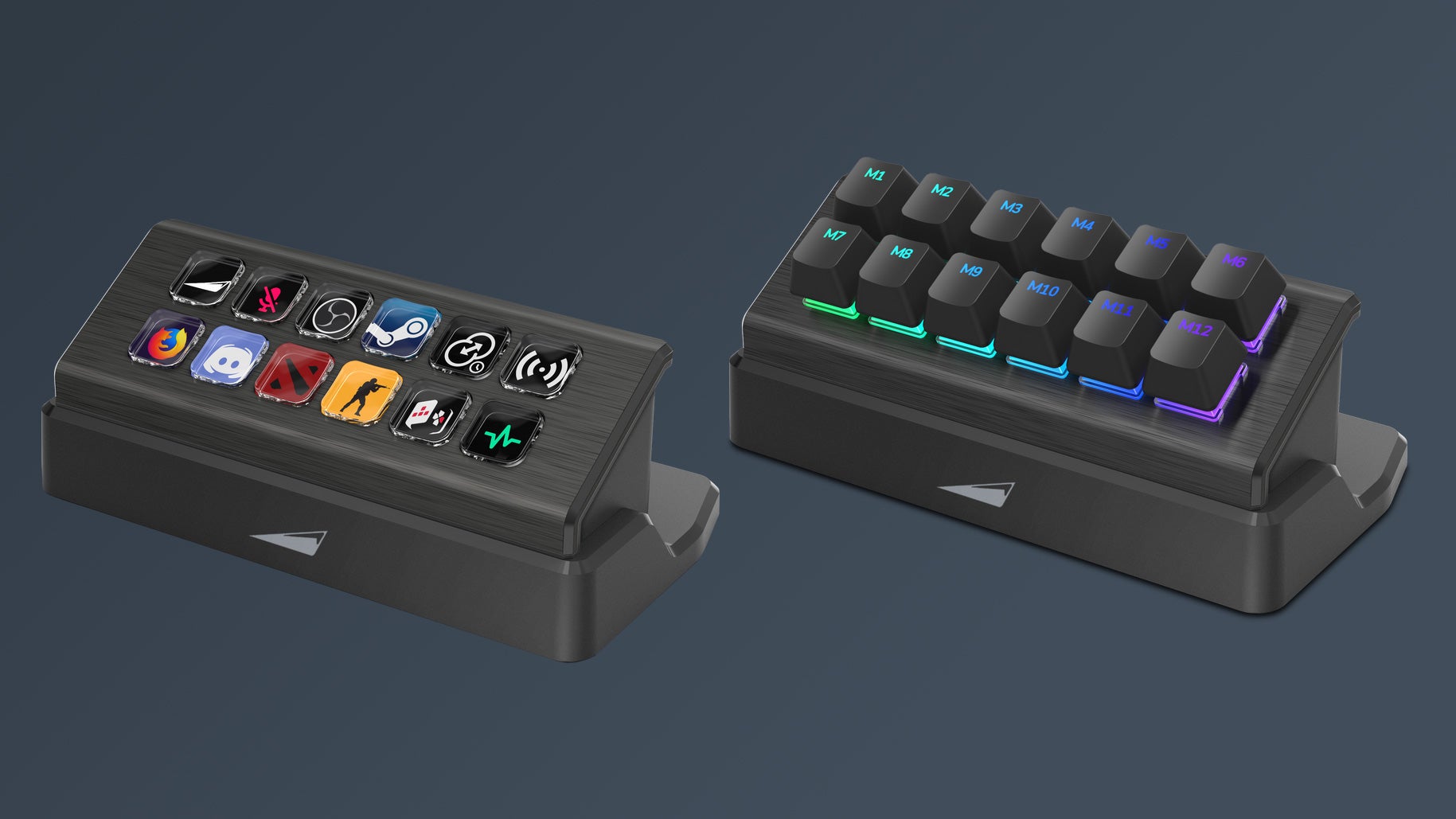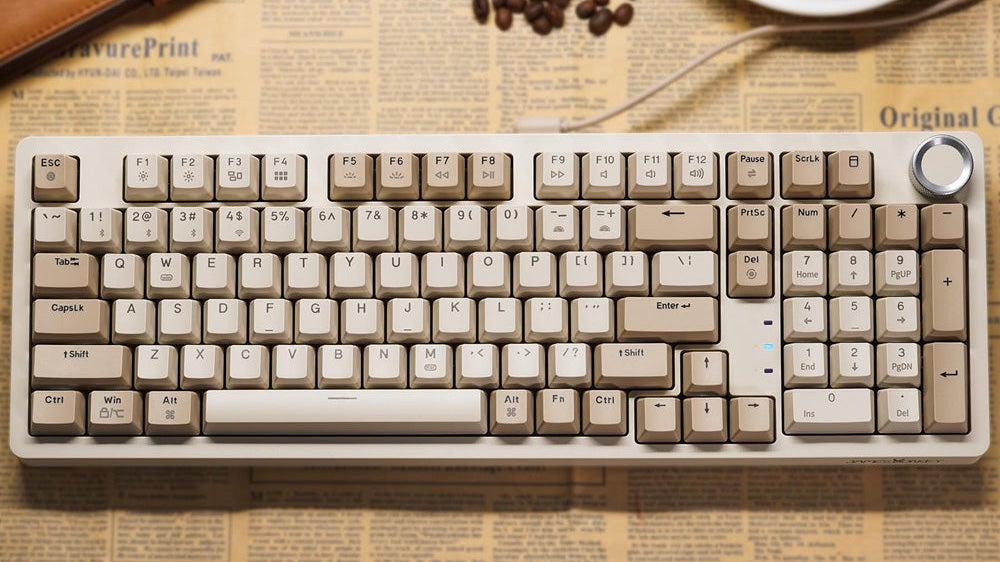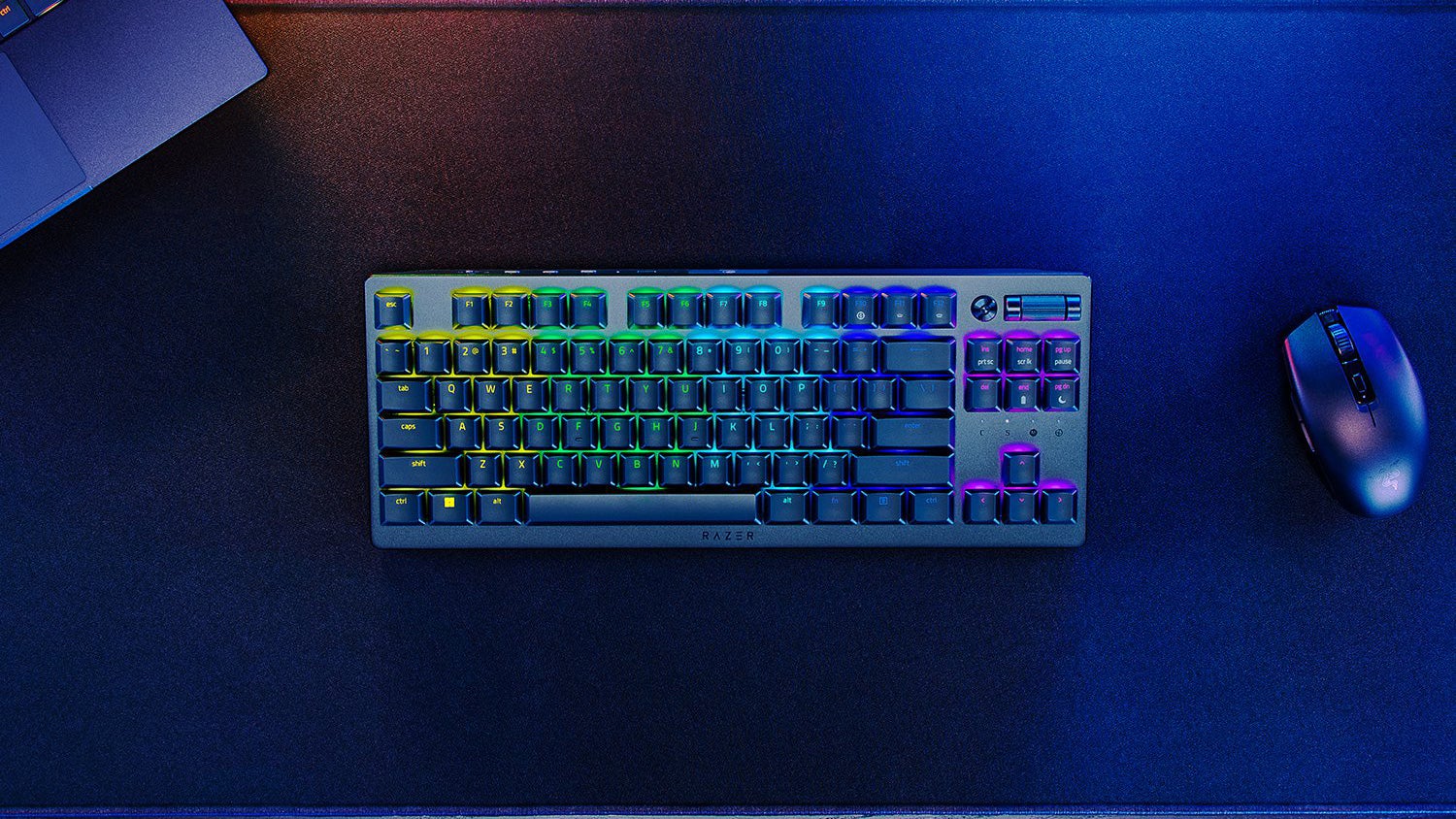So, without further ado, here are five more lovely mechanical keyboards to have been released in 2022, from technological marvels to some uniquely aesthetic creations. Enjoy!
Wooting 60 HE review: a 60 percent analogue keyboard
Over in the Netherlands, keyboard firm Wooting has made a name for itself with a series of analogue mechanical keyboards that offer some unique advantages over more traditional designs. We’ve gone into more detail in past reviews - see our Wooting Two HE review, for example - but the main idea is that every key’s movement can be measured, allowing you to turn a key into an analogue input, trigger different effects at different key depths and so on. Their latest board is the Wooting 60 HE, a 60 percent size model that is ideally suited for the competitive-minded gamers that are most likely to be interested in its feature set. As well as offering the smallest - and therefore most convenient - way to access Wooting’s unique hardware and software combo, the 60 HE is also just a lovely keyboard to use and behold. The compact design looks great on a desk, with brilliant RGB backlighting, a slim bevelled frame and an optional fabric strap emblazoned with the words ‘Take Control’ - an idea that I’m sure will be copied by other keyboard makers in the years to come. The soft linear switches also work brilliantly, producing a pleasantly deep sound when typing. The black-and-yellow colour scheme is a nice alternative to the reds, blues and greens that tend to be more commonplace in the major gaming brands. The standard UK layout also means that you can use a wide range of custom keycap sets; I opted for Razer’s white ‘Phantom’ keycaps, so-named because the key legends are only visible when backlit. With the keyboard’s lighting set to a golden yellow in the Wootility software, the effect is rather lovely. Of course, this software also makes it easy to change the keyboard’s WASD keys into analogue inputs, set the point at which a pressed key is recognised by the keyboard, or engage ’tachyon mode’ to reduce input lag substantially. The Wooting 60 HE is the best keyboard the company has ever produced, a wonderful distillation of their best features into a lovingly-designed and sturdily-constructed compact chassis. If the form factor suits, it comes with a strong Digital Foundry recommendation at €189.
Mountain Everest Max plus DisplayPad and MacroPad
OK, this one is a keyboard that I’ve covered before. We named the Everest Max the best modular keyboard, and I stand by that assertion. Now though, there’s the potential for the Max to become even more powerful, with the release of the £100 DisplayPad and £50 MacroPad. These are two modular add-ons to the Max, which add either twelve mechanical keys or twelve Stream Deck-style key/screen combos. They slide directly onto the chassis of the Everest Max - although not the Everest 60, sadly - and make it easy to add a ton of extra controls to your keyboards. The DisplayPad and MacroPad also each come with their own chunky bases, which angle the keys up at a comfortable position. Streaming is obviously a big focus here, but it’s just the tip of the iceberg as you can assign each key to basically anything through the power of macros. I used mine to trigger various scripts I use to speed up writing articles and sending tweets - stuff like copy-pasting the beginnings of a deals post, or shortening and adding affiliate tracking to a retailer link. You don’t have to put in much legwork if you don’t want to though, with predefined actions for programs like OBS, Photoshop, Illustrator, Premiere Pro, Davinci Resolve and more. In practice, these are well-designed enough to make these immediate productivity bonuses, and the macro recording functions are deep enough that you could automate loads if you put your mind to it. YouTuber and friend of Digital Foundry EposVox’s video on the MacroPad and StreamPad are well worth looking at to see some other exciting options. Perhaps the only disadvantage here is that these aren’t quite as seamless as the rest of the Everest ecosystem. You can’t just click these into place to connect them to your keyboard; instead, power restraints mean that you’ll need to connect them to your PC directly, which means extra cables on what might already be a messy-looking desk. It’s an understandable restriction, but it’s a shame that Everest couldn’t make this work in a cleaner way. Ultimately though, a very cool value-add for any Everest Max owners, and these could work as a potential standalone alternative to the better-known Stream Deck too - although Corsair/Elgato definitely possess the better ecosystem at this stage. Still, a worthy effort and a genuine evolution on the formula.
James Donkey RS2 review: gasket-mount retro stylings
One of the major trends for this year in mechanical keyboards is gasket mounts, which use a softer, elastic material between the plate and the keyboard to offer smoother and quieter keypresses. We saw a few options the last time we looked at recent keyboard releases, and now we’ve got another: the RS2 from the brilliantly-named Chinese firm James Donkey. This keyboard has a retro beauty, with a two-tone off-white colourway (‘ancestor gray’) straight out of the 90s, but it also embraces the future with hot-swap Gateron G Pro Red or Brown switches, PBT keycaps, USB-C charging, 2.4GHz wireless and Bluetooth.
Interestingly, the RS2 also comes in a uniquely compact 99-key ‘full-size’ layout. The navigation cluster here has been reduced to just two keys - Print screen and Delete - with Insert, Page Up, Page Down, Home and End being relegated to the Fn layer. That provides more space for a clickable volume wheel in the upper right, as well as a calculator button above the numpad. Other keys on the right side of the keyboard are also different sizes or in different positions, which makes it more difficult to find replacement keycap sets. However, these changes do ensure that the keyboard takes up less space than your average full-size keyboard, which perhaps makes the mental remapping necessary to learn the new layout worthwhile.
While the layout changes aren’t a clear improvement over more standard designs, the actual typing experience here is excellent for a $99 keyboard. The premium keycaps and gasket-mount Gateron Brown switches provide extremely smooth action, with just enough tactile feedback and a pleasant thock-y report. Wireless latency was good via the included 2.4GHz dongle, and a bit worse via Bluetooth; using the keyboard wired via USB-C is also a perfectly fine alternative if you’re using the keyboard in a fixed position and don’t mind an extra cable. Battery life is quoted at four weeks, which is believable given the modest single-colour lighting.
If you like the retro look and the flexibility afforded by this keyboard appeals, it’s well worth considering - just be prepared to get used to that slightly different layout.
Razer Deathstalker V2 Pro Tenkeyless review: low profile wireless
The DeathStalker V2 Pro Tenkeyless is another in Razer’s long line of overly long product names (hi, BlackWidow V3 Mini HyperSpeed Phantom Edition), but that long name conceals what is the best alternative yet to Logitech’s excellent G915 TKL which we currently recommend as the best wireless mechanical keyboard. Both keyboards are low profile options, providing the snappy actuation of a good laptop keyboard with the tactilty of real mechanical switches, multiple connectivity options (low latency 2.4GHz wireless, Bluetooth, USB-C) and an absolutely lovely scroll wheel. While Logitech’s design is impressive, I think the Razer board is superior. For me, it all comes down to the typing experience, and Razer’s optical low profile linear switches, which feel super-satisfying under the finger - despite relatively slippery ABS keycaps. They actuate quickly with just 1.2mm of travel, but I never felt like I was pressing them accidentally as you get a decent amount of tactile feedback as you bottom out. Another advantage is the volume wheel and multi-function button in the upper right of the keyboard. This feels great to use - even if Logitech’s is slightly wider and nicer - but the button is a game-changer, offering an easy way to play/pause, skip and skip back with one, two or three quick taps in a row respectively. Profile buttons, the USB-C port and a wired/BT/2.4GHz switch are on the back of the keyboard for a cleaner design up top. There’s even a way to check the current battery life; you can press Fn + End to see four tiny LEDs light up above the arrow keys, each segment corresponding to 25 percent of the battery or about 12.5 hours (for 50 hours in total) with the RGB lighting on; with it off you’re looking at closer to 200 hours. The whole platform feels premium too, with the metal-topped chassis and slim dimensions making for an elegant design. However, the DeathStalker V2 Pro TKL does have a few flaws too. For anyone that relies on the PrtScr for taking screenshots (hi!), moving it to the Function row can be annoying - even though it unlocks that lovely volume wheel. The keyboard is also expensive at $220/£220, and you’d have to really like this feature set and form factor to justify the expense. However, like Logitech, I expect Razer will be aggressive with their pricing for sales events like Black Friday, and this keyboard easily outclasses most $100 to $150 wireless keyboards available.
Marvo KG972W review: an affordable gasket-mount keyboard
This one is the simplest keyboard of the lot, so I’ll keep it short and sweet. Why consider this keyboard? It’s fairly expensive at $129, yet it nails the essentials and comes with a (relatively) unique design. The 98 percent design is space-saving compared to a full-size board, but maintains both the numpad and arrow keys. The switches, available in tactile and linear varieties, are hot-swappable (3/5-pin) and gasket-mounted, and the PBT double-shot keycaps won’t wear away unlike ABS alternatives. There are three connectivity modes - 2.4GHz wireless, Bluetooth and USB via a fancy coiled cable - and a 3000mAh battery ensures weeks of operation without RGB, or days with. Speaking of RGB, there’s a wide variety of modes, and you don’t need software to set it up - although some is available if you prefer. The overall look of the keyboard is also neat. It comes in a choice of four pleasant colourways, including ’tiffany’ blue, pink, black and white, and there’s a cutout in the upper right of the keyboard with a transparent plastic insert. By default it just lights up, but you can ask Marvo’s customer service to send you a print-out of a design of your choice to be illuminated and make the keyboard your own. Altogether, it’s nothing revolutionary, but for the money it offers a strong typing experience and a deep feature set that should appeal to a wide range of people.
Wrapping up
So - there we have it! Five more lovely keyboards from all over the world, from the Netherlands and Germany to China and America. Which keyboard was your favourite? Is there a brilliant keyboard out there that I haven’t covered? Let me know in the comments below!




